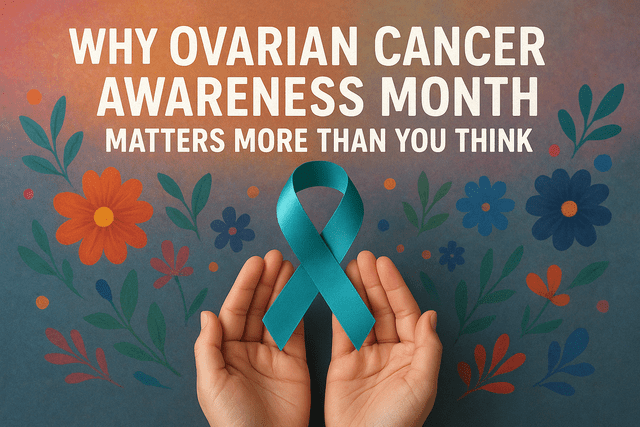
Teal Talks: Why Ovarian Cancer Awareness Month Matters More Than You Think
When people talk about cancer, most think about the ones that are mentioned all the time—like breast cancer or lung cancer. Ovarian cancer doesn’t always make it into those conversations, even though it affects thousands of women every year. That’s one of the big reasons September is dedicated to spreading the word. Ovarian Cancer Awareness Month isn’t just another date on the calendar. It’s a chance to remind everyone that awareness can lead to earlier diagnosis, stronger support, and even better research.
Table of Content
Why Awareness Months Exist in the First Place
At first, it might seem odd that certain diseases or causes get an entire month set aside for them. But the truth is, awareness months actually work. When something gets a spotlight for weeks at a time, people who might never have thought about it suddenly start paying attention. Schools bring it up in classes, doctors share resources, and communities host events. Awareness months also give survivors and families a chance to share their stories, which makes the issue feel more real to others.
For ovarian cancer, awareness is critical because the symptoms are often easy to miss. Things like bloating, stomach pain, or feeling full quickly can be brushed off as normal. By having an entire month to highlight these signs, more women may realize it’s worth checking out sooner. That’s one way awareness directly connects to saving lives.
Why September Goes Teal
Each awareness month comes with a color, and teal has become the symbol for ovarian cancer. In September, you’ll often see buildings lit up in teal or people wearing teal ribbons. While the color itself might seem like a small detail, it works as a signal. It gets people to ask questions, and those questions open the door to conversations. A ribbon might seem simple, but if it gets even one person to learn the symptoms, it’s worth it.
People sometimes underestimate how powerful a month of focus can be. Ovarian Cancer Awareness Month brings attention that might otherwise get lost in everyday life, reminding everyone that this disease deserves just as much notice as the ones we hear about more often.
The Challenge of Spotting Ovarian Cancer
One of the hardest parts about ovarian cancer is how sneaky it can be. Unlike some other cancers, it doesn’t always show clear signs early on. That means it often gets diagnosed in later stages, when it’s harder to treat. This is one of the main reasons awareness matters so much. If more people knew the early warning signs, more cases could be caught sooner.
Symptoms can include feeling full after small meals, changes in bathroom habits, pelvic pain, or ongoing bloating. These don’t always mean cancer, but when they continue for weeks, they shouldn’t be ignored. The problem is that many people brush these signs off or assume they’re related to something harmless. By bringing them up in campaigns, awareness month helps make sure they aren’t dismissed so easily.
Why Talking Makes a Difference
It can feel uncomfortable to bring up health problems, especially ones that involve parts of the body people don’t often talk about. That silence can be dangerous. Awareness month gives everyone permission to break through that discomfort. When women hear that others have faced the same symptoms, they’re more likely to speak up and ask their doctors questions.
Talking openly also helps families. For example, some types of ovarian cancer can be linked to family history and genetics. When relatives share information, others in the family may decide to get tested or pay closer attention to their own health. Conversations that might feel awkward at first can actually give people tools to protect themselves.
The Role of Research and Support
Awareness months aren’t only about sharing symptoms. They also push research forward. The more attention ovarian cancer gets, the more likely it is to receive funding for studies and new treatments. Low-Grade Serous Ovarian Cancer, a rare type, is one example where awareness has helped increase focus. Even though it doesn’t affect as many people as other cancers, every step forward in research has the power to change lives.
Support groups also grow stronger during these awareness periods. Families and survivors connect with one another, finding comfort in knowing they’re not facing the journey alone. That community strength makes a huge difference in coping with such a tough illness.
How Young People Can Help
It’s easy to think that cancer awareness only matters to older adults, but that isn’t true. Teens and young adults can also play an important role. Sharing posts online, wearing teal, or just reminding loved ones to pay attention to symptoms are small actions that spread awareness. Even just talking with friends about what ovarian cancer is and how it shows up can make an impact.
Health isn’t always a popular topic in everyday conversations, but that’s why awareness months are so powerful. They make it feel normal to bring up subjects that people usually avoid. When younger voices join in, the message travels even further.
More Than a Month
Ovarian Cancer Awareness Month might be in September, but its lessons last all year. Once someone learns the symptoms or hears a survivor’s story, that knowledge doesn’t go away. It might even be passed along later, at a time when it’s needed most. That’s the ripple effect of awareness—it keeps moving outward, reaching more people than we can count.
Even though the month has a clear start and end date, the conversations it sparks don’t stop when the calendar changes. Every ribbon worn, every teal light on a building, and every shared story adds to a growing chain of knowledge and support.
Final Thoughts
Ovarian cancer may not get as much attention as some other cancers, but awareness months like September help change that. They remind us to listen to our bodies, talk to our doctors, and share information with others. They also show that even small efforts, like wearing teal or posting online, matter more than most people realize.
The real power of Ovarian Cancer Awareness Month isn’t just in the color teal or the events held during September—it’s in the conversations that continue long after. Each one has the potential to bring comfort, encourage action, and maybe even save a life.


